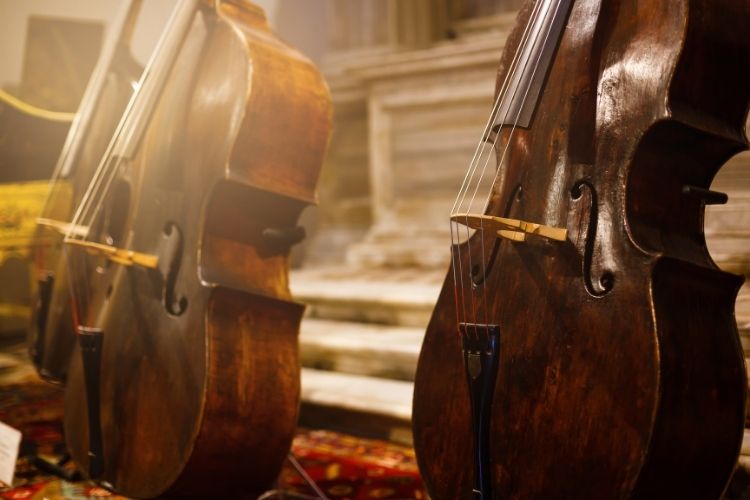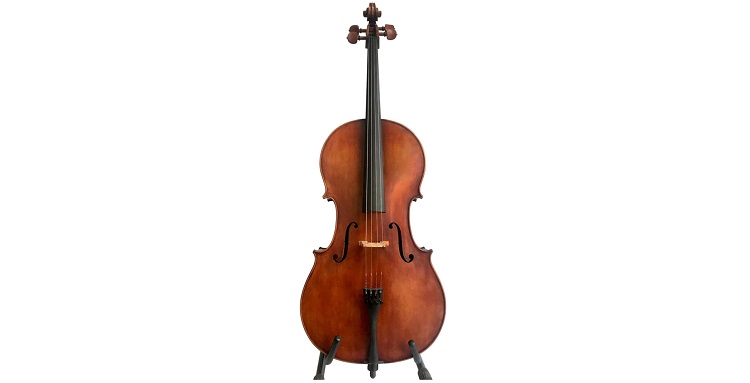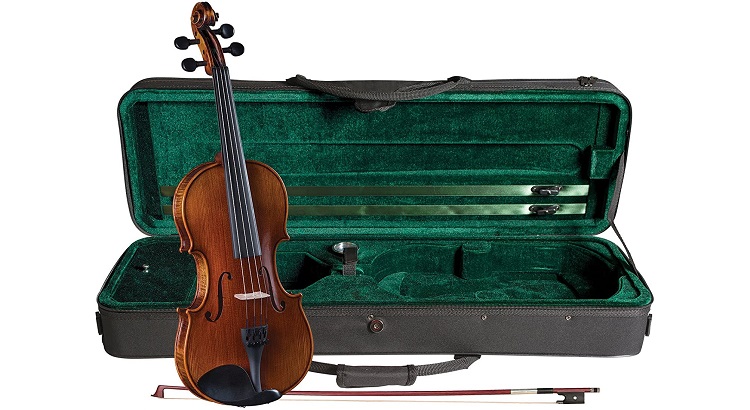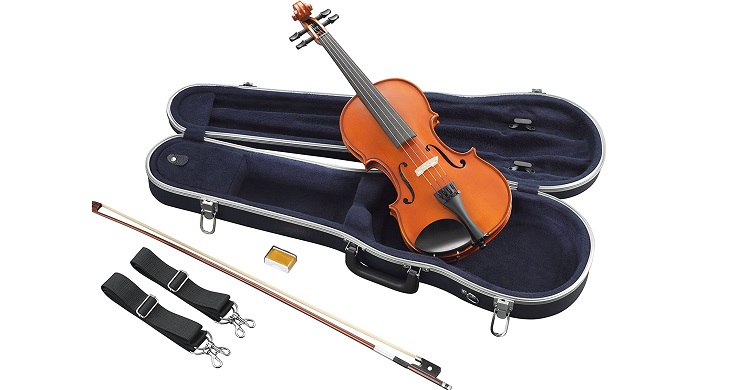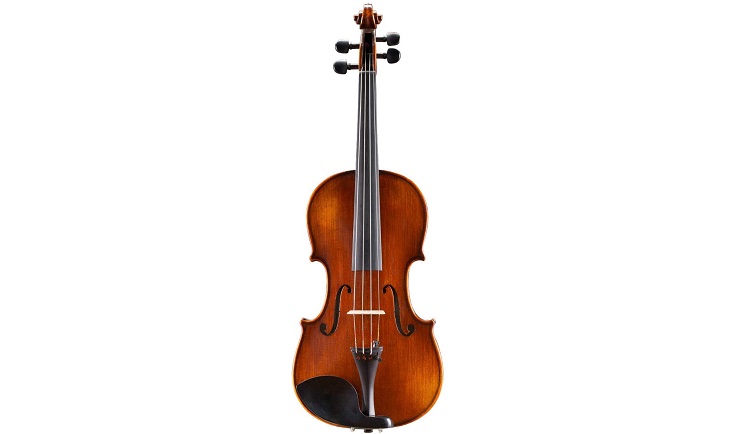- Cecilio CCO 400 Review and Guide - February 21, 2022
- Cecilio CCO 500 Review and Guide - February 17, 2022
- Cecilio CCO 600 Review and Guide - February 9, 2022
When you buy an item using one of our links, we may earn a portion of the sale. Strings Guide and some products featured on the site are owned by the same company. Learn More.
Do you want to eventually debut in Carnegie Hall or join the New York Philharmonic? Read about the cello vs. violin explained so that you can determine which instrument will help you meet your goals.
While both members of the string family sound great, they have their differences. Understanding those factors may help you eliminate one in favor of the other.
Main Differences Between Cellos vs Violins
The main differences between cellos vs violins are:
- The cello is a bigger instrument, whereas the violin is much smaller
- The cello can read music in the bass, tenor, and treble clefs, whereas violin music is only in treble clef
- The cello sits between the player’s legs, whereas the violin rests on the player’s shoulder
- The cello can play the melody and the bass line, whereas the violin can’t play low enough for the bass line
- The cello costs quite a bit of money, whereas similar violins are more affordable
Think about why these differences matter in practice.
Size and Range
If you play the cello, you’ll have four strings with open notes: C, G, D, and A. This gives the instrument a range of the C two octaves below middle C (C2) to the C two octaves above middle C (C6).
However, the violin is much smaller and so has a smaller range, from the G below middle C (G3) to the A almost four octaves above middle C (A7). The violin’s strings can produce the notes G, D, A, and E when you keep them open.
These differences make the violin easier to transport because of its smaller size. But the cello can offer a rich, resonant sound due to the larger body.
Reading Music
Both instruments read music in concert pitch, meaning that the note you see on the page is the same as the pitch you hear. However, learning to read the music for violin and cello can be different.
If you choose to play the violin, you’ll only need to read one clef: treble clef. To play the extreme low and high notes, you need to be able to read and recognize ledger lines.
On the other hand, cello music rarely uses more than a few ledger lines. Instead, you have to be able to read bass, tenor, and treble clefs to play the entire range of the cello.
Instrument Position
Another significant difference between the cello and violin is how you hold the instrument to play. If you play the violin, you will rest it between your chin and left shoulder.
Then, you’ll use your left hand to press down the strings and your right hand to either bow or pluck the strings. However, the cello is too big to place between your chin and shoulder.
To play the cello, you’ll pull out the endpin from the bottom of the instrument and rest it on the floor. Place the cello between your legs, and bring the fingerboard up to your left shoulder.
Ensemble Roles
Both the cello and violin are part of the standard symphony orchestra, chamber orchestra, and string quartet. The violins are split into two sections, and the first violins tend to have the melody.
Meanwhile, the second violins can have the melody or a harmony part. In ensemble music, the cellos may have any part, from the melody to the harmony to the bass line.
In an orchestra, the top player of the first violin section will also serve as the concertmaster. They will introduce the orchestra and help tune before a rehearsal or performance.
The Cost
Of course, you can’t have the cello vs. violin explained without learning about their cost. Both instruments can range in price from a few hundred dollars to a few million dollars.
But when comparing cellos and violins of the same quality, the cello will usually cost more. After all, the larger size cellos requires more materials to produce.
That can increase the time it takes to make a cello, especially if you purchase a handmade instrument. If you compare the same make and model, the cello costs much more than the violin.
How to Choose Between the Cello and Violin
Once you understand the differences between the cello and violin, you may know which is right for you. But you may love both instruments equally.
If that’s the case, consider a few steps you can take to narrow your choice. Then, you can consider a few benefits of each instrument.
Hopefully, one string instrument will end up as the clear winner.
Your Size
Fortunately, the cello and violin both come in multiple sizes, so you can find one that fits you. However, the cello is always going to be bigger than the violin.
If you don’t have the space to store the cello, the violin may be the right choice for now. The violin is also easier to transport, so you may want to play it if you want to go to frequent rehearsals or if you can’t practice where you live.
Another thing to consider if you feel comfortable playing with the cello between your legs. If your legs are short, it may be hard to stretch them far apart to accommodate the cello.
Your Interests
Think about what interests you as a musician, such as the genres you want to play or the role you want to play in a group. Knowing what type of music or part you want to play can help you decide between the instruments.
Then, you might find that one instrument meets your needs much better than the other. However, the cello and violin are both pretty versatile, so you don’t have to play one type of music.
You can find the violin and the cello in orchestras but also in non-classical settings. For example, Lindsey Sterling is a well-known crossover violin player. She’s done covers of pop songs and written her own music.
Your Access
Unfortunately, your decision to play the cello or violin may come down to what instrument you can get. If you’re on a tight budget, you may have to look for the cheapest option available, new or used.
Or you might not be able to afford to buy anything, so you may need to borrow an instrument. In some cases, you may have access to the cello and violin, but you might not get to choose.
And if you want to go to rehearsals, consider your ability to transport the cello. If you need to take a bus or walk, you may not want to carry the cello around.
Your Colleagues
While you should like the instrument you play, you can use other musicians to help make your choice. Perhaps you want to join a local orchestra, and they have plenty of violin players.
You’ll probably have a better chance of getting into the orchestra if you play the cello. As long as you have some interest in learning the cello, it could be a good option.
However, don’t let the instrumentation of local groups force you to play an instrument you don’t like. It won’t be worth it because you won’t want to keep practicing and improving.
Your Budget
No matter what instrument you want to learn, you should get the best model you can afford. In general, the violin is going to be more affordable than the cello at all levels.
However, you may be able to find a used cello for a fraction of its original price. If that happens, you may get a better deal on it than you would if you bought a new violin.
Be sure to consider the many options of each instrument as you can. That way, you’ll be able to choose the ideal instrument and model for you.
Benefits of Playing the Cello
You’ve considered all of the factors that differentiate the cello and the violin. But maybe you still can’t decide which instrument you should learn.
To help make your choice, consider some amazing benefits of playing the cello that you won’t get with the violin. Maybe the advantages will sway you one way or the other.
Various Roles
The cello can be an amazing solo instrument, and there are solos from the Baroque was to the present. But you can also play the cello in an orchestra or in smaller ensembles.
Of course, it’s part of the string quartet, but it’s also an amazing continuo instrument. If you like Baroque music, you can play with a harpsichord player and a violin or flute soloist to fill out the accompaniment.
In ensembles, the cello can also play other harmonic and melodic roles. So if you like to challenge yourself, the cello may be the best instrument for you.
Warm Tone
If you’ve ever heard a beginner practice the violin, you may associate that with a bunch of screeches. While the violin can sound good at an advanced level, the cello sounds warmer and richer from the beginning.
You’ll need to practice music either way, but you may find the cello more satisfying to play. And you won’t have to worry about annoying your family or neighbors as much.
As you improve your cello playing, you can get an even richer tone from the instrument. Then, you can enjoy all kinds of music with that sound.
On Violin Hickey
Violin and viola players can develop hickey-like marks from practicing. Depending on the sensitivity of your skin, you may get a dark spot on your neck.
That doesn’t always look good, but you don’t have to worry about that when you play the cello. All you have to do is set up your instrument, practice, and put the cello away.
Of course, you can cover up a hickey violin, but it’s still annoying. The presence or absence of one may also attract judgment because some believe it shows how much you play. However, some people are more prone to having hickeys.
Best Cellos
Do you want to take advantage of the benefits that cells have to offer? To make the most of those benefits, you need to know about the best cellos.
Then, you can test and compare instruments that will work well and help you learn. Here are a few cellos you should try.
Cremona SC-200
The Cremona SC-200 is an excellent beginner model. It uses spruce and maple to allow you to get a warm, full sound out of the instrument.
Cremona sets up this model to national music education standards, so it’s perfect for use in a school orchestra. But you can also play it as a soloist, so it’s perfect for kids and adults.
This model comes with a balanced bow that can help you play more easily. And while it’s a beginner instrument, you can keep playing this model as you advance.
Pros
- Great for beginners
- eat with a bow
- looks good
Cons
- a bit expensive
DZ Strad 250
If you’re looking to upgrade to a better cello, the DZ Strad 250 may be a good fit for you. The cello is handmade and comes in multiple sizes so that you can be comfortable.
Aged maple and spruce make up the body to help provide a warm and full tone to your playing. There’s also a nice varnish that makes the instrument look just as good as it sounds.
You can play this cello for years, and it’s a great model for casual players. It offers a more refined sound than a beginner model, but it’s not nearly as expensive as a professional cello.
Pros
- versatile
- looks and sounds good
- great for casual musicians
Cons
- Not for beginners
DZ Strad 500
The DZ Strad 500 is an excellent introduction to the world of professional cellos. Luthiers make the cello by hand using tonewoods from the Italian Alps, which is very close to the area where Stradivari obtained wood for instruments.
You’ll also get a bow and rosin, so you have everything you need to start playing. And you can even choose between a 3/4 and 4/4 model so that you can be comfortable.
This model offers an open sound with plenty of resonance, so it’s great for solo and group playing. If you’re serious about playing the cello, this can be a good instrument to try.
Pros
- Good for advanced players
- fantastic tonewoods
- Multiple sizes
Cons
- pretty expensive
Benefits of Playing the Violin
It wouldn’t be fair to have the cello vs. violin explained without also discussing the benefits specific to the smaller string instrument. If you aren’t quite convinced that the cello is what you should play, maybe the violin is for you.
Consider the following reasons why you may want to play the violin instead of the cello or any other instrument.
Plenty of Opportunities
In orchestras and string quartets, there are twice as many violin parts as cello parts. That means it may be easier for you to join such groups.
You can also perform as a soloist or in groups with other instrumentations. If you know someone who plays the flute, for example, you can read the same range, making it easy to find duets to learn and perform.
The violin can take over for almost any instrument that reads music in the treble clef. That can make it easier to find playing opportunities outside of groups with standard instrumentations.
Small
While the violin isn’t the smallest instrument, it is the smallest member of the string family. That makes it easy to find a spot to store your gear when you aren’t playing.
And when you need to travel with your violin, doing so will be easy. You don’t need a huge car or an extra plane ticket to take your violin on tour or to a local rehearsal.
If you aren’t very strong or live in a small apartment, the violin is great. It can fit under your bed for storage, and you can take it with you almost anywhere.
Diverse Repertoire
The violin also has plenty of diverse repertoire within the world of classical music. You can play concerts by Mozart, Mendelssohn, and many other composers.
Outside of classical music, the violin often makes an appearance in folk music. Plus, you can always learn from Lindsey Sterling to create your own pop sound as a violinist.
While you can do the same on the cello, it may be harder to do so as a soloist. On the other hand, the violin makes for the perfect melodic instrument.
Best violins
Would you prefer to enjoy the benefits of playing the violin? If you decide the smaller instrument is the right one for you, that’s great.
But you still need to decide which model to get as you start or improve your playing. Consider these in your search.
Cremona SV-500
The Cremona SV-500 is an amazing beginner violin at a great price point. You can also choose it as a first upgrade if you start on a lower-quality model.
Either way, the violin uses fantastic tonewoods and has a good, durable design. This model makes it easy to get a good sound, even as a new violin player.
You’ll also get a bow, rosin, strings, and a case to protect everything. That way, you can take your violin to rehearsals or lessons, or you can keep it at home.
Pros
- Affordable
- good for students
- sounds great
Cons
- quality control problems
Yamaha V3
Yamaha is an amazing musical instrument company, and the V3 violin is a testament to that. This model is 4/4, so it’s great for older beginners.
It looks and sounds great, and it’s also reliable for students. The wood is durable and can withstand a lot of use, so it’s nice if you want to play the violin a lot.
You also get a bow and other accessories, so you can start playing. However, it’s not the most budget-friendly model on the market.
Pros
- Sounds and looks good
- Comes with accessories
- good for students
Cons
- expensive
Andreas Eastman Model 305
The Andreas Eastman Model 305 is yet another amazing violin to try. It features a spruce and maple body, which is common among violins, so you can get a traditional sound.
Everything comes in a protective case, which is great for transportation and storage. But you can easily take the violin out of the case when you want to play.
While it’s not the cheapest student violin, it’s still pretty affordable. And you’ll be able to get a lot of use out of it as long as you take good care of the instrument.
Pros
- good sound
- Suitable for beginners
- Comes with what you need
Cons
- a little expensive
FAQs About Cello Vs. Violin Explained
Answer: Both the cello and violin present unique pros and cons, and one isn’t always easier than the other. Instead of thinking about the easier option, think about what interests you more.
Learning any instrument takes time and effort, so choosing the instrument you like will set you up for success. I tried multiple instruments before settling on one, and I have stuck with that choice for many years because I love it.
Answer: If you want to learn BOTH the cello and violin, you may want to start with the violin. It’s smaller and therefore easier to hold and learn as a beginner.
Switching to the cello, later on, will be easier as you get older and grow more, if you’re still growing. However, don’t be afraid to learn the cello first if you would prefer.
Answer: The violin is probably the best option for most solo players. Yes, you can find plenty of solo cello music, but the violin has a higher range that we typically equate to the melody.
Aside from the massive classical violin repertoire, you can read vocal lines in popular music. So you may find that the violin sounds better than the cello when you play without other people.
Answer: Both the cello and violin fit in well in the modern orchestra. If you’re looking to join a beginner orchestra, the better instrument will be the one that your orchestra needs more of.
So if there are tones of cello players, you might want to start on the violin. However, in most cases, you should choose the instrument you want to play based on the sound or the role you want to have in an orchestra.
Answer: You can travel with either a violin or a cello, but the violin is much easier. Most violins can fit in most vehicles, so you don’t need a huge car or van to travel by car.
If you need to take your instrument on a plane, the violin will most likely fit in the overhead bin. However, you’d need to buy a second ticket to fit your cello in the cabin.
Never check your string instrument if you can avoid it. The lack of climate control can affect the wood, and other luggage may damage the instrument if bags go on top of it.
Answer: In most cases, a violin will be cheaper than a comparable cello. The cello’s larger size requires more materials and time to produce, especially at a high quality.
However, you can play the cello if you’re on a budget. Just make sure you save up for a good instrument, and you’ll be able to learn the instrument of your dreams.
Final Note on Cello Vs. Violin Explained
Having the cello vs. violin explained can help you decide which instrument is the right choice for you. While both offer unique advantages and disadvantages, one may be better for you.
Be sure to consider the violin and the cello, and think about the type of music you want to play. Then, you can select the instrument that makes more sense for your needs as a musician.


